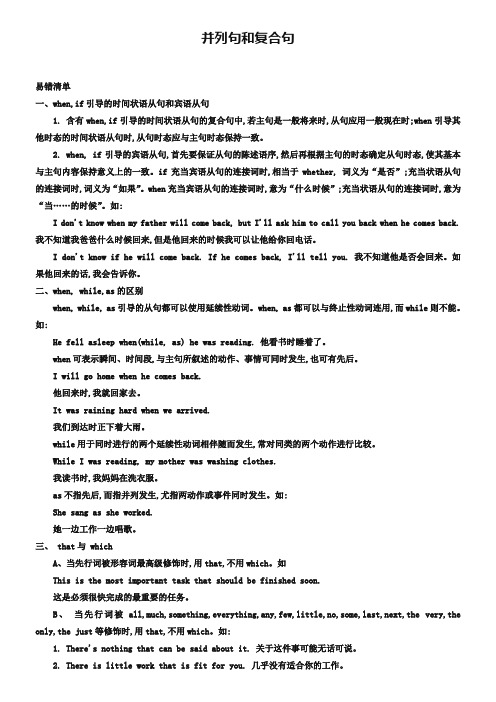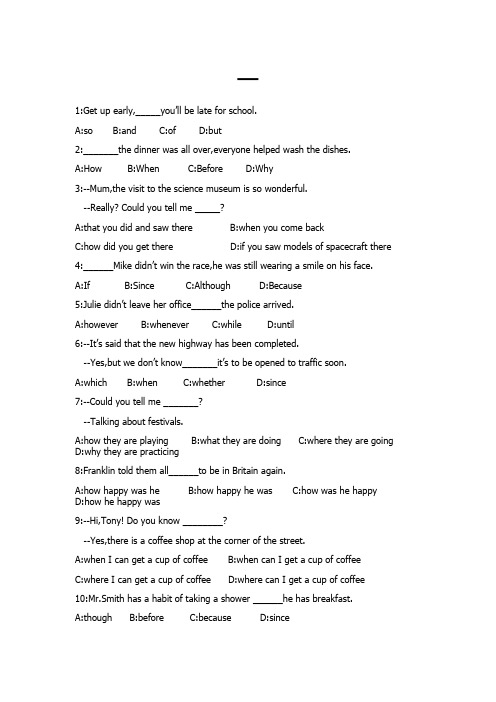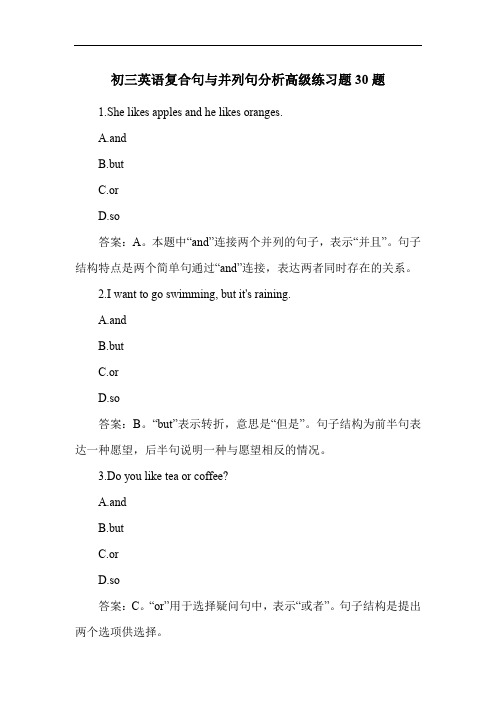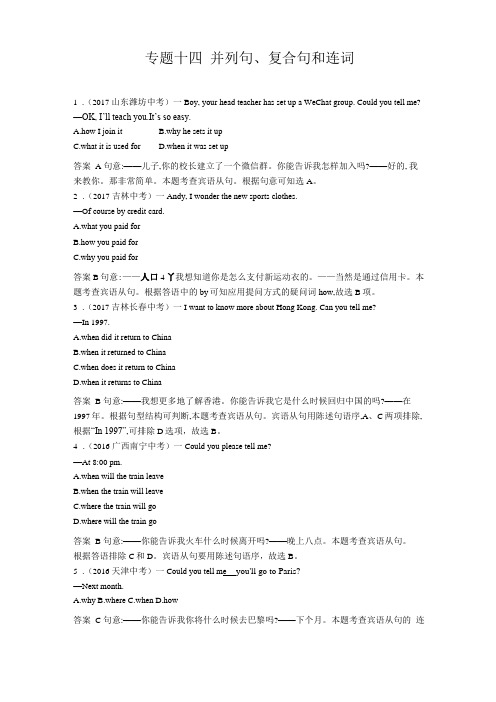并列句、复合句和连词精选中考试题
中考英语简单句、并列句和复合句专项训练-最新

中考英语简单句、并列句和复合句专项训练·最新巩固练习I. 同义句转换,每空限填一词。
1. He was tired, but he still worked very hard._Although_______ he was tired, he still worked very hard.2. My brother sleeps with the window closed. He doesn’t do it when it is really too hot.My brother sleeps with the window closed ________ it is really too hot.3. What’s Miss Lee’s e-mail address? Do you know?Do you know what ________ ________ ________ ________ ________ ?4. Andy told me, “I will fly to London tomorrow. ”Andy told me that ________ ________ ________ ________ ________ the next day.5. I like the computer. My parents bought it for me last week.I like the computer ________ ________ ________ ________ for me last week.巩固练习II. 根据括号内的要求完成下列各题,每空限填一词(含缩略形式)。
1. The villagers built many new houses themselves.(改为否定句)The villagers __________ __________ many new houses themselves.2. I went to bed at ten last night. (改为一般疑问句)__________ you __________ to bed at ten last night?3. Mr. King has to stay at home. (改为一般疑问句)__________ Mr. King __________ to stay at home?4. His friend has already posted the letter. (改为一般疑问句)__________ his friend __________ the letter yet?5. Will they take a trip next month? (补全否定答语)__________, they __________.6. I am looking for my sister. (对划线部分提问)__________ __________ you looking for?7. They are Tim’s knives. (对划线部分提问)__________ knives are they?8. My Aunt is a nurse. (对划线部分提问)__________ __________ a nurse?9. My brother studied at No.1 Middle School last year. (对划线部分提问)__________ __________ your brother __________ last year?10. The building is tall. (改为感叹句!)__________ __________ the building is!__________ __________ __________ building it is!巩固练习III. 根据句意及所给汉语提示,写出句中所缺内容(每空词数不限)。
中考英语常考易错点专题讲练:并列句和复合句(含答案解析)

并列句和复合句易错清单一、when,if引导的时间状语从句和宾语从句1. 含有when,if引导的时间状语从句的复合句中,若主句是一般将来时,从句应用一般现在时;when引导其他时态的时间状语从句时,从句时态应与主句时态保持一致。
2. when, if引导的宾语从句,首先要保证从句的陈述语序,然后再根据主句的时态确定从句时态,使其基本与主句内容保持意义上的一致。
if充当宾语从句的连接词时,相当于whether, 词义为“是否”;充当状语从句的连接词时,词义为“如果”。
when充当宾语从句的连接词时,意为“什么时候”;充当状语从句的连接词时,意为“当……的时候”。
如:I don't know when my father will come back, but I'll ask him to call you back when he comes back. 我不知道我爸爸什么时候回来,但是他回来的时候我可以让他给你回电话。
I don't know if he will come back. If he comes back, I'll tell you. 我不知道他是否会回来。
如果他回来的话,我会告诉你。
二、when, while,as的区别when, while, as引导的从句都可以使用延续性动词。
when, as都可以与终止性动词连用,而while则不能。
如:He fell asleep when(while, as) he was reading. 他看书时睡着了。
when可表示瞬间、时间段,与主句所叙述的动作、事情可同时发生,也可有先后。
I will go home when he comes back.他回来时,我就回家去。
It was raining hard when we arrived.我们到达时正下着大雨。
while用于同时进行的两个延续性动词相伴随而发生,常对同类的两个动作进行比较。
并列句和复合句练习(中考题)

一1:Get up early,_____you’ll be late for school.A:so B:and C:of D:but2:_______the dinner was all over,everyone helped wash the dishes.A:How B:When C:Before D:Why3:--Mum,the visit to the science museum is so wonderful.--Really? Could you tell me _____?A:that you did and saw there B:when you come backC:how did you get there D:if you saw models of spacecraft there 4:______Mike didn’t win the race,he was still wearing a smile on his face.A:If B:Since C:Although D:Because5:Julie didn’t leave her office______the police arrived.A:however B:whenever C:while D:until6:--It’s said that the new highway has been completed.--Yes,but we don’t know_______it’s to be opened to traffic soon.A:which B:when C:whether D:since7:--Could you tell me _______?--Talking about festivals.A:how they are playing B:what they are doing C:where they are going D:why they are practicing8:Franklin told them all______to be in Britain again.A:how happy was he B:how happy he was C:how was he happy D:how he happy was9:--Hi,Tony! Do you know ________?--Yes,there is a coffee shop at the corner of the street.A:when I can get a cup of coffee B:when can I get a cup of coffeeC:where I can get a cup of coffee D:where can I get a cup of coffee10:Mr.Smith has a habit of taking a shower ______he has breakfast.A:though B:before C:because D:since11:--What do you think of your Junior Middle School life?--I think it is colourful,______I am always busy.A:if B:though C:while D:until12:_______you smile at others,they will smile back.A:Before B:When C:Until D:Though13:--Could you tell me _______it’s polite to eat noisily in Japan,Kumiko?--Sure!It’s polite to do that. It means you like the food very much.A:if B:where C:how14:--Which song do you like better,Lucy?--I prefer the song Little Apple______can attract many people.A:which B:who C:whom D:where15:Sitting down after a walk is relaxing.But do you dare to sit on a seat______tells you your weight?A:whom B:/ C:who D:that16:--Could you tell me ________?--You’d better keep a diary in English as often as possible.A:when I can improve my written English B:how I can improve my written English C: if can I improve my written English17:You must make sure your tea is not too hot______you drink it.A:before B:after C:since D:while18:Have you ever heard of the news_______is about the Strawberry Concert?A:who B:what C:which D:when19:Phone me ______you get to Wuzhong.A:since B:so that C:as soon as D:while二1:_______he was very tired, he continued working in his office.A:Since B:Although C:As soon as D:Because2:I have some tickets for the basketball match.I wonder______.A:where you buy the tickets B:why you like to go thereC:if you’d like to come along D:when you watch the match3:He’s not a perfect child. He sometimes talks back ______his parents talk with him. A:if B:before C:when D:until4:Don’t run in the classroom, ______you may burt yourself.A:and B:or C:but D:so5:--Shall we go for a picnic in the forest park tomorrow?--Yes,______it rains heavily.A:if B:unless C:until D:when6:--I can’t decide_______on vacation. Any advice?--What about Hainan? It’s warm in winter.A:when I will go B:where will I go C:when will I go D:where I will go 7:--In a text message,88 means bye-bye.--And another example is F2F_____stands for face to face.A:that B:who C:whom D:it8:________I am in trouble, my classmates will help me out.A:Before B:Whenever C:Though9:Do you know the man_______is talking to Miss Wu?A:he B:whom C:who D:which10:I don’t remember_______the book yesterday.A:where I put B:where did I put C:where will I put D:where I will put 11:You will be late for school________you don’t get up early.A:but B:if C:and D:or12:The movie______we saw last night was fantastic.A:that B:what C:whose D:who13:The beginning of the movie was boring,______the end was amazing!A:but B:and C:so D:or14:A friend is someone_______says,”What! You too? I thought I was the only one!”A:who B:which C:what D:whose15:To help others is more valuable than anything else.______we show our love and care to others,the world will be full of happiness and pleasure.A:As long as B:As many as C:As tall as16:Martin and his friends didn’t eat up all the food they ordered,______they took the rest away.A:for B:or C:so D:as17:______my father_______my mother take good care of me .I love them so much. A:Either;or B:Both;and C:Neither;nor18:--Will you please give the dictionary to Jane?--Sure,I’ll give it to her_______she arrives here.A:before B:until C:because D:as soon as19:My father was preparing for his speech______my mother was doing some washing last night.A:if B:while C:unless D:until20:They will try their best in the Dragon Boat Racing______they may fail.A:if B:although C:unless D:until(模拟一)1:These are only twenty minutes left,_____we’d better take a taxi.A:so B:or C:but D:for2:There are lots of things ______I need to prepare before the trip.A:who B:what C:whom D:which3:Hurry up,______you’ll miss the train.A:but B:so C:and D:or4:--Miss Li always makes her classes lively and interesting.--Sure, I still remember every word _____she said at school.A:what B:when C:who D:that5:We can’t avoid traffic accidents______everyone follows the rules.A:unless B:if C:until D:though6:--Would you like to go to the cartoon show with me?--It sounds fun,_____I’m too busy.A:so B:for C:or D:but7:--I want to know _______.--I’m afraid that we can’t be there on time.A:why we arrived at the airport late B:if we will reach the airport lateC:how can we get to the airport D:when are we going to reach the airport 8:I love people______are friendly to others.A:which B:whose C:who9:As middle school students ,we should start thinking about ______for our country in the future.A:what we did B:what did we do C:what we can do D:what can we do 10:--_______you know when an idiom is being used,you can’t easily understand what you read.--I think so.11:--Why do you bring your own meals to school every day?--Because of the earthquake,we can’t have meals at school______the new dining hall is completed.A:until B:when C:if D:since12:--When are the Stutes leaving for New York?--Pardon?--I asked ___________.A:when are the Shutes leaving for New YorkB:when the Shutes are leaving for New YorkA:when were the Shutes leaving for New YorkA:when the Shutes were leaving for New York13:--I won’t go to the party tonight.--you told me you would. What’s the matter?A:So B:Or C:Because D:But14:--Excuse me,could you tell me _______?--There is a bank on the second floor.A:where I can exchange money B:how can I get to the bankC:that there’s a bank near here D:where is the bank15:The old lady lives alone,______she doesn’t feel lonely.A:so B:for C:but D:or16:I could speak ___French ___Chinese, but luckily I could talk with them in English. A:both;and B:neither;nor C:either;or D:not only;but also17:Susan won’t arrive at the airport on time _____she hurries up.A:once B:if C:or D:unless18:--We will fail the exam______we study hard.--That’s _____everyone is trying his best to prepare for the exam.A:until;why B:unless;when C:unless;why D:until;when(模拟二)1:It was dark,______I could see what was happening.A:or B:though C:but D:so2:I’m interested in______you have said.A:all that B:all what C:/ D:which3:It’s raining. Take an umbrella with you,_____you will get wet.A:and B:but C:so D:or4:--The light in the room is still on.Do you know ______?--In order to prepare for the coming exam.A:if he worked hard B:why he stays up late C:why is he so busyD:when he will stop working5:--Do you know _____our school?--The day after tomorrow.A:when the American students visit A:when the American students will visit A:when do the American students visit A:when will the American students visit 6:--What did you do in today’s history class?--We talked about the characters_____achieved fame in American historyA:who B:which C:/ D:what7:The teachers and the students_____came to visit Nanjing Museum are from England.A:that B:which C:what D:whose8:Get up early,______you will miss the bus.A:and B:or C:unless D:then9:--peter,could you tell me _________?-He is under the tree over there.A:where your father is B:what your father is C:how your father is10:Mr.White couldn’t get any news about his missing daughter,______he was very worried.A:but B:for C:or D:so11:The old lady donated much money to the poor students,_____she is not rich. A:though B:or C:so D:because12:--Could you tell me _________?--By speaking more.A:what I could do to improve my English B: how I can improve my EnglishC:how can I deal with my English D:what’s wrong with my English13:--May I come in? I’m sorry I am late.--Come in. Please tell me _______.A:why you are late again B:what were you doing C:who did you talk with 14:Peter likes to listen to Kelly Clarkson’s music______is very loud and full of energy. A:who B:whom C:whose D:which15:--What did the woman ask you just now?--She asked_______.A:who was waiting for B:whether could I help her to find the post officeC:how she can get to the post office D:which was the way to the post office 16:He didn’t catch the ball______his father threw to him.A:who B:what C:/ D:whose17:”Lost in Thailand” tells a story of three Chinese men ______meet on their trips to Thailand.A:who B:whom C:which D:what18:--Would you like to go hiking with me,Susan?--I’d like to, _______you don’t want to go alone.A:until B:before C:if D:after答案:(一)1-5:CBDCD 6-10:CBBCB 11-15:BBAAD 16-19:BACC (二)1-5:BCCBB 6-10:DABCA 11-15:BAAAA 16-20:CBDBB 模拟一:1-5:ADDDA 6-10:DBCCA 11-15:ADDAC 16-18:BDC 模拟二:1-5:DADBB 6-10:AABAD 11-15:ABADD 16-18:CAC。
中考英语复合句与并列句练习题50题含答案解析

中考英语复合句与并列句练习题50题含答案解析1.I will go to the park with my friends if it ____ sunny tomorrow.A.isB.wasC.will beD.has been答案解析:A。
if 引导的条件状语从句,主句用一般将来时,从句用一般现在时表将来。
B 选项was 是过去时,不符合;C 选项will be 时态错误;D 选项has been 是现在完成时,也不符合条件状语从句的时态要求。
2.She was doing her homework while her brother ____ football in the yard.A.playedB.was playingC.playsD.will play答案解析:B。
while 引导的时间状语从句,主从句动作同时进行,主句用过去进行时,从句也用过去进行时。
A 选项played 是一般过去时;C 选项plays 是一般现在时;D 选项will play 是一般将来时,都不符合要求。
3.We won't go on a picnic until it ____ raining.A.stopsB.will stopC.stoppedD.has stopped答案解析:A。
until 引导的时间状语从句,主句用一般将来时,从句用一般现在时表将来。
B 选项will stop 时态错误;C 选项stopped 是过去时;D 选项has stopped 是现在完成时,都不符合。
4.____ he was tired, he still helped his mother with the housework.A.AlthoughB.BecauseC.IfD.When答案解析:A。
although 引导让步状语从句,表示“虽然……但是……”。
B 选项because 表示原因;C 选项if 引导条件状语从句;D 选项when 引导时间状语从句,都不符合语境。
初三英语复合句与并列句分析高级练习题30题

初三英语复合句与并列句分析高级练习题30题1.She likes apples and he likes oranges.A.andB.butC.orD.so答案:A。
本题中“and”连接两个并列的句子,表示“并且”。
句子结构特点是两个简单句通过“and”连接,表达两者同时存在的关系。
2.I want to go swimming, but it's raining.A.andB.butC.orD.so答案:B。
“but”表示转折,意思是“但是”。
句子结构为前半句表达一种愿望,后半句说明一种与愿望相反的情况。
3.Do you like tea or coffee?A.andB.butC.orD.so答案:C。
“or”用于选择疑问句中,表示“或者”。
句子结构是提出两个选项供选择。
4.He is tall and handsome.A.andB.butC.orD.so答案:A。
“and”连接两个形容词,意思是“并且”。
句子结构为“主语+系动词+形容词1+and+形容词2”。
5.I studied hard, so I got good grades.A.andB.butC.orD.so答案:D。
“so”表示结果,意思是“所以”。
句子结构是前半句说明原因,后半句说明结果。
6.She can sing well and dance beautifully.A.andB.butC.orD.so答案:A。
“and”连接两个动词短语,表示“并且”。
句子结构为“主语+情态动词+动词短语1+and+动词短语2”。
7.I don't like apples or oranges.B.butC.orD.so答案:C。
“or”在否定句中连接两个并列的名词,表示“也不”。
句子结构为“主语+否定词+名词1+or+名词2”。
8.He is not only tall but also strong.A.andB.butC.orD.not only...but also...答案:D。
并列句、复合句和连词精选中考试题

专题十四并列句、复合句和连词1.(2017 山东潍坊中考)一Boy, your head teacher has set up a WeChat group. Could you tell me? —OK, I’ll teach you.It’s so easy.A.how I join itB.why he sets it upC.what it is used forD.when it was set up答案 A 句意:——儿子,你的校长建立了一个微信群。
你能告诉我怎样加入吗?——好的, 我来教你。
那非常简单。
本题考查宾语从句。
根据句意可知选A。
2.(2017 吉林中考)一Andy, I wonder the new sports clothes.—Of course by credit card.A.what you paid forB.how you paid forC.why you paid for答案B句意:——人口4丫我想知道你是怎么支付新运动衣的。
——当然是通过信用卡。
本题考查宾语从句。
根据答语中的by可知应用提问方式的疑问词how,故选B项。
3.(2017 吉林长春中考)一I want to know more about Hong Kong. Can you tell me?—In 1997.A.when did it return to ChinaB.when it returned to ChinaC.when does it return to ChinaD.when it returns to China答案 B 句意:——我想更多地了解香港。
你能告诉我它是什么时候回归中国的吗?——在1997年。
根据句型结构可判断,本题考查宾语从句。
宾语从句用陈述句语序,A、C两项排除, 根据“In 1997”,可排除D选项,故选B。
4.(2016 广西南宁中考)一Could you please tell me?—At 8:00 pm.A.when will the train leaveB.when the train will leaveC.where the train will goD.where will the train go答案 B 句意:——你能告诉我火车什么时候离开吗?——晚上八点。
中考英语复合句与并列句练习题50题含答案解析
中考英语复合句与并列句练习题50题含答案解析1.I don't know ________ he will come tomorrow.A.ifB.whenC.whatD.why答案解析:A。
选项A“if”表示“是否”,在句中符合语境,“我不知道他明天是否会来”。
选项B“when”表示“什么时候”,与题意不符;选项C“what”表示“什么”,也不符合句子意思;选项D“why”表示“为什么”,在这里不合适。
此句考查宾语从句连接词的用法,根据句子意思来选择合适的连接词。
2.Could you tell me ________ you did last Sunday?A.whereB.whatC.whichD.how答案解析:B。
选项B“what”在句中表示“什么”,“你能告诉我你上周日做了什么吗”,符合语境。
选项A“where”表示“哪里”;选项C“which”表示“哪一个”;选项D“how”表示“怎样”,都不符合句子意思。
此句考查宾语从句连接词的用法,根据句子意思来选择合适的连接词。
3.I wonder ________ he can finish the work on time.B.ifC.whenD.what答案解析:B。
选项B“if”表示“是否”,“我想知道他是否能按时完成工作”,符合语境。
选项A“that”在宾语从句中无实际意义,只起连接作用,在此处不符合;选项C“when”表示“什么时候”;选项D“what”表示“什么”,都不合适。
此句考查宾语从句连接词的用法,根据句子意思来选择合适的连接词。
4.Do you know ________ he is looking for?A.whoB.whoseC.whomD.what答案解析:D。
选项D“what”表示“什么”,“你知道他在找什么吗”,符合语境。
选项A“who”表示“谁”,作主语;选项C“whom”表示“谁”,作宾语,但此处不是指人;选项B“whose”表示“谁的”,不符合句子意思。
初三英语复合句与并列句分析基础练习题50题含答案解析
初三英语复合句与并列句分析基础练习题50题含答案解析1.She likes apples,______ he likes oranges.A.andB.butC.orD.so答案解析:B。
“but”表示转折,她喜欢苹果,但是他喜欢橘子。
“and”表示并列;“or”表示选择;“so”表示结果。
根据语境,这里是转折关系。
2.I have a pen,______ I don't have a pencil.A.andB.butC.orD.so答案解析:B。
“but”表示转折,我有一支钢笔,但是我没有铅笔。
“and”表示并列;“or”表示选择;“so”表示结果。
根据语境,这里是转折关系。
3.He is tall,______ his brother is short.A.andB.butC.orD.so答案解析:B。
“but”表示转折,他很高,但是他的弟弟很矮。
“and”表示并列;“or”表示选择;“so”表示结果。
根据语境,这里是转折关系。
4.She can sing,______ she can't dance.A.andB.butC.orD.so答案解析:B。
“but”表示转折,她会唱歌,但是她不会跳舞。
“and”表示并列;“or”表示选择;“so”表示结果。
根据语境,这里是转折关系。
5.I like English,______ my sister likes Chinese.A.andB.butC.orD.so答案解析:B。
“but”表示转折,我喜欢英语,但是我的姐姐喜欢语文。
“and”表示并列;“or”表示选择;“so”表示结果。
根据语境,这里是转折关系。
6.He is good at math,______ he is weak in English.A.andB.butD.so答案解析:B。
“but”表示转折,他擅长数学,但是他在英语方面很薄弱。
“and”表示并列;“or”表示选择;“so”表示结果。
专题十五 并列句和复合句(试题部分)
—3 years old.
A.how old is Lang Lang B.how old Lang Lang is
C.how old was Lang Lang D.how old Lang Lang was
答案 D 句意:——我想知道郎朗开始学钢琴的时候多大?——三岁。本题考查宾语从句和
时态。宾语从句要用陈述句语序,排除A、C两项;由下文的began可知此处用一般过去时,故选
中考英语 (广东专用)
专题十五 并列句和复合句
五年中考
A组 2014—2018年广西中考题组
1.(2018广东,44)—Could you tell me
you'd like me to pay you?
—You'd better use mobile payment. I don't care
it is Ali Pay or WeChat Pay.
A.that B.which C.who D.whom 答案 A 句意:在过去的10年里我们的城市发生了巨大变化。对我来说,出现在我眼前的一 切都是新的。本题考查定语从句。由先行词Everything可知关系代词应用that,故答案为A 项。
8.(2016广东,45)—I wonder
.
—It will fall on a Saturday.
A.who B.whom
C.which D.whose
答案 A 句意:——你认识正在演讲的那位女士吗?——当然认识。她是一位著名的叫屠呦
呦的科学家。她获得了2015年诺贝尔奖。本题考查定语从句,先行词为lady,设空处在从句中
作主语,故选A项。
深度解析 本题考查定语从句关系词的辨析。当先行词指人时,关系代词可以是:who/whom/
中考英语复合句与并列句单选题40题
中考英语复合句与并列句单选题40题1. I was reading a book ______ my mother was cooking.A. whileB. whenC. asD. after答案:A。
本题考查while引导的时间状语从句。
while强调主从句动作同时发生,“我在读书”和“我妈妈在做饭”这两个动作同时进行。
when 也可引导时间状语从句,但更强调一个动作在另一个动作发生时突然发生。
as 表示“一边……一边……”,通常两个动作同时进行,语气较弱。
after 表示“在……之后”,不符合语境。
2. We'll go for a picnic ______ it doesn't rain tomorrow.A. ifB. untilC. becauseD. though答案:A。
本题考查if引导的条件状语从句。
if 表示“如果”,“如果明天不下雨,我们就去野餐”。
until 表示“直到……”。
because 表示“因为”。
though 表示“虽然”。
3. You should be friendly to others ______ you want to make more friends.A. soB. ifC. butD. or答案:B。
本题考查if引导的条件状语从句。
if 表示“如果”,“如果你想交更多朋友,你应该对别人友好”。
so 表示“所以”。
but 表示“但是”。
or 表示“或者”。
4. ______ he is very tired, he still keeps working.A. BecauseB. AlthoughC. ButD. So答案:B。
本题考查although引导的让步状语从句。
although 表示“虽然”,“虽然他很累,但他仍然继续工作”。
because 表示“因为”。
but 表示“但是”,不能与though/although 同时使用。
- 1、下载文档前请自行甄别文档内容的完整性,平台不提供额外的编辑、内容补充、找答案等附加服务。
- 2、"仅部分预览"的文档,不可在线预览部分如存在完整性等问题,可反馈申请退款(可完整预览的文档不适用该条件!)。
- 3、如文档侵犯您的权益,请联系客服反馈,我们会尽快为您处理(人工客服工作时间:9:00-18:30)。
专题十四并列句、复合句和连词1.(2017山东潍坊中考)—Boy, your head teacher has set up a WeChat group. Could you tell me?—OK, I’ll teach you.It’s so easy.A.how I join itB.why he sets it upC.what it is used forD.when it was set up答案A句意:——儿子,你的校长建立了一个微信群。
你能告诉我怎样加入吗?——好的,我来教你。
那非常简单。
本题考查宾语从句。
根据句意可知选A。
2.(2017吉林中考)—Andy, I wonder the new sports clothes.—Of course by credit card.A.what you paid forB.how you paid forC.why you paid for答案B句意:——Andy,我想知道你是怎么支付新运动衣的。
——当然是通过信用卡。
本题考查宾语从句。
根据答语中的by可知应用提问方式的疑问词how,故选B项。
3.(2017吉林长春中考)—I want to know more about Hong Kong. Can you tell me ? —In 1997.A.when did it return to ChinaB.when it returned to ChinaC.when does it return to ChinaD.when it returns to China答案B句意:——我想更多地了解香港。
你能告诉我它是什么时候回归中国的吗?——在1997年。
根据句型结构可判断,本题考查宾语从句。
宾语从句用陈述句语序,A、C两项排除,根据“In 1997.”,可排除D选项,故选B。
4.(2016广西南宁中考)—Could you please tell me?—At 8:00 pm.A.when will the train leaveB.when the train will leaveC.where the train will goD.where will the train go答案B句意:——你能告诉我火车什么时候离开吗?——晚上八点。
本题考查宾语从句。
根据答语排除C和D。
宾语从句要用陈述句语序,故选B。
5.(2016天津中考)—Could you tell me you’ll go to Paris?—Next month.A.whyB.whereC.whenD.how答案C句意:——你能告诉我你将什么时候去巴黎吗?——下个月。
本题考查宾语从句的连接词。
why 为什么;where 在哪儿;when 什么时候;how 如何。
根据回答可知选C项。
16.(2016宁夏中考)Go back you come from.A.whyB.whereC.whenD.how答案B句意:从哪里来回哪里去。
本题考查连词。
why为什么;where哪里;when什么时间;how怎样。
根据句意选B。
7.(2016福建福州中考)—Mr. Black, could you tell me ?—At 10:00 tomorrow morning.A.where we’ll go hikingB.when we’ll have a meetingC.whether you’ll come to my birthday party答案B句意:——布莱克先生,你能告诉我我们什么时候开会吗?——明天上午10点。
本题考查宾语从句。
由答语“明天上午10点”可知问句询问的是时间,故选B。
8.(2015湖北黄冈中考)—Which song do you like better,Lucy?—I prefer the song Little Apple can attract many people.A.whichB.whoC.whomD.where答案A句意:——Lucy,你更喜欢哪首歌?——我更喜欢那首能够吸引很多人的歌——《小苹果》。
本题考查定语从句。
定语从句的先行词为the song Little Apple,指物且在从句中作主语,关系词应用which或that,故答案为A。
9.(2015广东中考)Running Man is a very relaxing TV program is hot among the young people.A.whatB.whichC.whoD.whom答案B句意:《奔跑吧兄弟》是一个十分令人放松而且在年轻人中很受欢迎的电视节目。
本题考查定语从句。
由先行词program在从句中作主语可知关系代词应用that/which,故答案为B项。
10.(2014河北中考)Eric arrived on time,it was the rush hour.A.thoughB.becauseC.whileD.unless答案A句意:尽管是(上下班时的)交通高峰期,但Eric按时到达了。
本题考查连词。
though 尽管;because 因为;while当……时候,然而;unless除非。
根据句意可知答案为A项。
11.(2014北京中考)I’d like to go with you,I’m too busy.A.orB.andC.soD.but答案D句意:我想和你一起去,但我太忙了。
本题考查连词辨析。
or或者,表示选择关系;and 和,又,表示并列关系;so所以,表示因果关系;but但是,表示转折关系。
题干中两个分句之间为转折关系,故选D。
12.(2014天津中考)It was raining heavily,we decided to stay at home and watch TV.A.butB.orC.becauseD.so答案D句意:雨下得正大,所以我们决定待在家里看电视。
本题考查连词。
but 但是;or 或者;because 因为;so 所以。
由句意可知选择D项。
13.(2014上海中考)John didn’t give up looking for a job he got an offer from a German company.A.untilB.sinceC.becauseD.if2答案A句意:John没有放弃寻找工作,直到他被一家德国公司聘用。
本题考查连词。
not...until...直到……才……,根据句意可知答案为A项。
14.(2014河南中考)—Excuse me,can you tell me?—Sorry,I don’t know.You can go to the information desk.A.that there is a trainB.when the train leavesC.which train can I takeD.where does the train go答案B句意:——打扰一下,你能告诉我火车什么时候开吗?——对不起,我不知道。
你可以去服务台问一下。
本题考查宾语从句。
宾语从句用陈述句语序,故排除C、D两项,又根据句意可知答案为B项。
15.(2014河南中考)He’s not a perfect child.He sometimes talks back his parents talk with him.A.ifB.beforeC.whenD.until答案C句意:他不是个十全十美的孩子。
他有时在父母和他谈话时会顶嘴。
本题考查连词。
if如果;before在……之前;when当……时候;until直到……为止。
根据句意可知答案为C项。
16.(2014安徽中考)Rick has learned a lot about Chinese culture he came to China.A.beforeB.whenC.untilD.since答案D句意:自从Rick来到中国,他已经学到了很多中国文化。
本题考查引导状语从句的连词的用法。
before在……之前;when当……时候;until直到……为止;since自从。
由从句用一般过去时,主句用现在完成时可知设空处用since引导时间状语从句,故选D项。
17.(2014广东中考)—Shall we go for a picnic in the forest park tomorrow?—Yes,it rains heavily.A.ifB.unlessC.untilD.when答案B句意:——我们明天去森林公园野餐怎么样?——可以,除非下大雨。
本题考查连词的用法。
if如果;unless除非;until直到;when当……时候。
结合句意可知,此处应选unless。
18.(2014四川成都中考)—Excuse me,do you know?—About five minutes’ walk.A.where the hospital isB.how far the hospital isC.how I can get to the hospital答案B句意:——打扰一下,你知道医院离这里多远吗?——走路大约五分钟。
根据About five minutes’ walk.可知问的是距离,故选B项。
19.(2014广西南宁中考)The bell rang the teacher was explaining the experiment to the students.A.untilB.beforeC.whileD.after答案C句意:当老师在向学生们说明这个实验的时候,铃声响了。
本题考查连词辨析。
until 直到……为止;before在……之前;while当……的时候;after在……之后。
根据句意可知C项正确。
20.(2014广东广州中考)Mum says I do my homework now,I can watch TV for an hour tonight.3A.ifB.thoughC.becauseD.while答案A句意:妈妈说如果我现在做作业,今天晚上就可以看一个小时电视。
本题考查连词的用法。
if如果;though虽然;because因为;while当……的时候。
根据句意可知用if表条件。
故答案为A项。
21.(2014黑龙江哈尔滨中考)Our hometown has changed a lot these years.These pictures can show you in the past.A.what our hometown looked likeB.what was our hometown likeC.how our hometown looked like答案A句意:这些年我们的家乡已经变化了许多。
